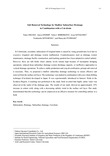Salt Removal Technology by Shallow Subsurface Drainage in Combination with a Cut-drain
JIRCAS Working Report
| ISSN | 1341710X |
|---|---|
| 書誌レコードID(総合目録DB) | AA11159468 |

本文フルテキスト
jircas_working_report88-_111-118.pdf521.31 KB
In Uzbekistan, secondary salinization of irrigated lands is caused by rising groundwater level due to excessive irrigation and drainage system malfunction. Countermeasures such as drainage system maintenance, drainage facility construction, and leaching opration have been adopted to control salinity. However, there are still fields where salinity levels remain high because of incomplete dredging operations, reduced deep subsurface drainage system discharge capacity, or ineffective approaches to vertical drainage operations. To achieve stable production and crop diversification, prompt salt removal is necessary. Thus, we proposed a shallow subsurface drainage technology to ensure effective salt removal from the surface soil layer. The technology was studied in combination with a new drain drilling technique (Cut-drain) developed in Japan. It was experimentally introduced in farmers’ fields in the Syrdarya Region. A leaching test performed in the study field revealed that highly saline water was observed at the outlet of the drainage pipe. The results of our study showed an approximately 20% increase in cotton yield, along with a decreasing salinity trend in the surface soil layer. Our study demonstrated that this technology can be employed as an effective measure for controlling salinity in a field.
| 刊行年月日 | |
|---|---|
| 作成者 | Yukio OKUDA Junya ONISHI Yulia I. SHIROKOVA Iwao KITAGAWA Yoshinobu KITAMURA Haruyuki FUJIMAKI |
| 著者キーワード | Salinization Drainage Subsurface drainage Cut-drain |
| 巻 | 88 |
| 開始ページ | 111 |
| 終了ページ | 118 |
| 関連するリソース | 部分である : JIRCAS Working Report no.88 |
| 言語 | eng |
関連する刊行物
部分である
